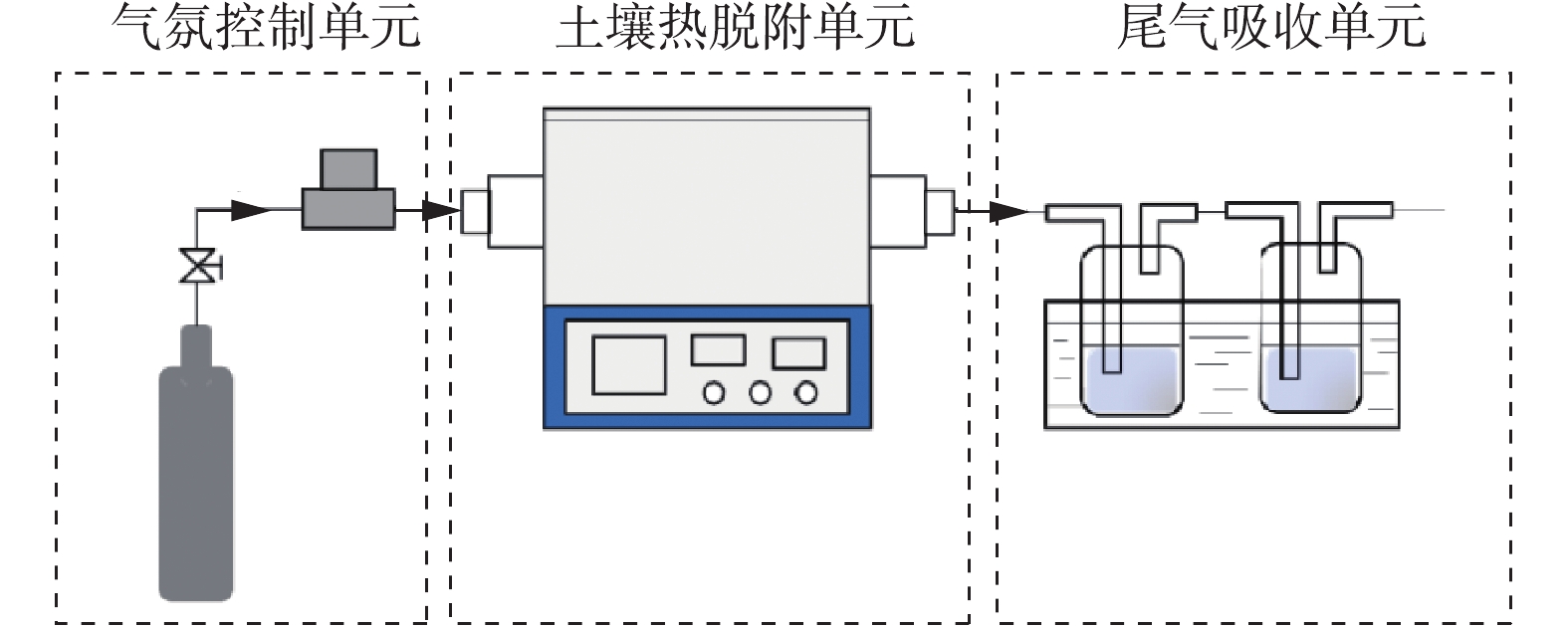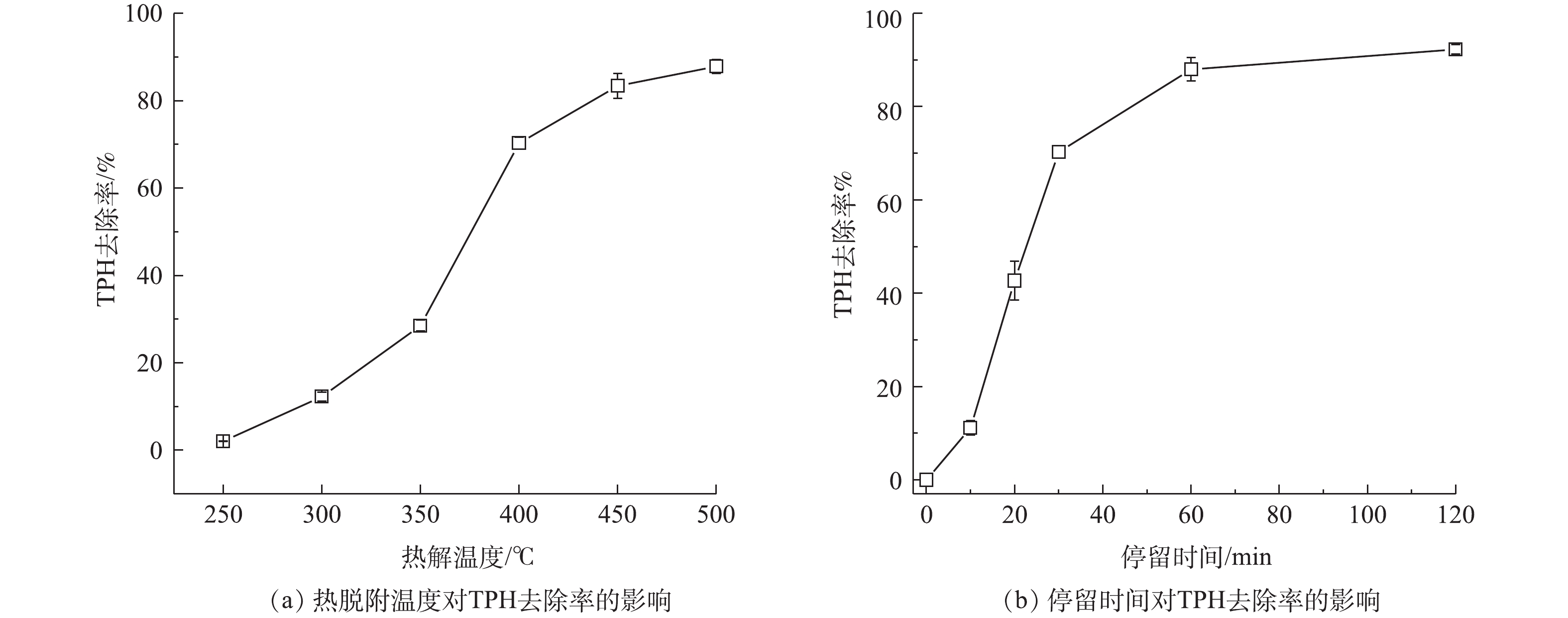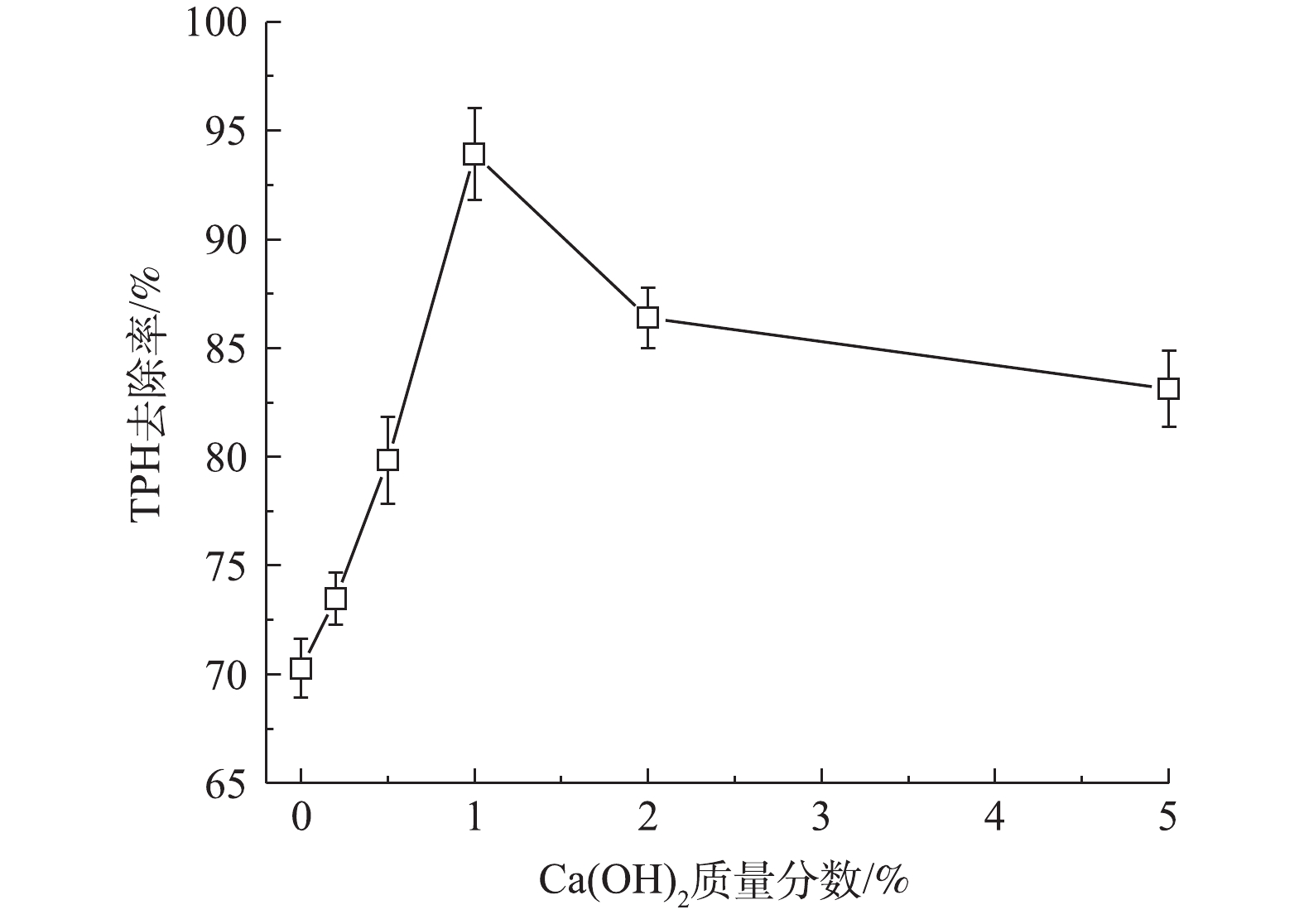-
石油开采、冶炼、运输和使用过程中因渗漏、溢出排放的石油类污染物在土壤中累积,对土壤环境造成了严重的危害[1]。石油污染物的组分复杂,主要包括脂肪烃、芳香烃、胶质和沥青质,普遍具有强疏水性,且含有大量的致癌、致畸类物质。石油污染物一旦进入土壤环境,可引起土壤的理化性质变化(如堵塞土壤孔隙、改变土壤有机质组成和结构等),进而改变甚至破坏土壤生态系统,其还会挥发到空气及向下迁移到地下水中威胁人类的健康[2-3]。我国勘探和开发的油田、油气田超过400个,分布在全国25个省、市、自治区,油田覆盖地区的面积超了3×105 km2,约占我国土地总面积的3%。其中,约有4.8×104 km2的土壤因受到石油勘探、开采、运输以及存储等过程的影响而被污染[4-5]。因此,亟需对石油污染土壤进行修复。
热脱附技术是通过直接或间接热交换,将土壤中的污染物加热至足够高的温度,使污染物从土壤中挥发或分离的过程。因其具有操作灵活、运行稳定、处理效率较高等优点而在有机污染土壤修复中被大量应用[6-9]。VIDONISH等[7]将人工配制石油污染土壤在420 ℃热处理3 h后,发现高沸点石油烃在低于沸点的温度下转化为类焦炭物质,去除污染物的同时提升了土壤肥力。LI等[8]在500 ℃对人工配制石油污染土壤热处理30 min时,土壤中总石油烃几乎完全去除。这些研究存在处理时间较长(3 h)或温度较高(500 ℃)的不足。另外,这些研究均采用人工配置石油污染土壤,与人工配置石油污染土壤相比,实际石油污染土壤由于自然风化作用,导致土壤中残留的主要为高沸点重质石油烃污染物[10-13],土壤中污染物更加难以去除。为了降低热脱附修复石油污染土壤的能耗,使用添加剂在相对较低的温度下强化热脱附的修复效果是一种新的研究方向。FRANKIN等[14]研究发现,含钙的矿物质可以降低沥青煤热处理过程中焦油产量,增加气体产物。周锦文[15]利用Ca(OH)2强化热处理煤的研究结果表明,Ca(OH)2能够使焦油二次热解及对煤的初始分解具有较强的催化作用,降低焦炭产率、增加气体产率。这些研究表明,Ca(OH)2具有强化热脱附修复石油污染土壤的潜力。但Ca(OH)2对重质石油污染土壤强化热脱附的修复效果还有待研究。
本研究选取山东东营石油污染土壤为实验土壤,以廉价易得的Ca(OH)2强化热脱附重质石油烃污染物,研究了热脱附温度、停留时间、添加剂用量等对重质石油污染土壤中总石油烃去除率的影响,并对热脱附前后土壤微观形貌的变化进行了分析,以期为Ca(OH)2类添加剂促进热脱附技术在石油污染土壤修复应用中的节能降耗提供参考。
全文HTML
-
本研究供试土壤采于山东东营胜利油田,采集的供试土壤剔除植物根系及砾石土块,并于室内自然条件下风干,过2 mm标准筛备用。该石油污染土壤中TPH浓度为119 g·kg−1,pH为7.3。
-
丙酮(CH3COCH3)、三氯甲烷(CHCl3)、正己烷(C6H14)、二氯甲烷(CHCl2)、无水乙醇(C2H5OH)、氢氧化钙(Ca(OH)2)均为分析纯;管式炉(MAC3A,北京弗恩森电炉有限公司)、紫外分光光度计(U-3010,株式会社日立制作所)、天平(ML204,梅特勒-托利多仪器有限公司)、超声波清洗仪(KQ-500DB型,昆山市超声仪器有限公司)、恒温水浴锅(HH-4,国华电器有限公司)、旋转蒸发仪(R系列,上海申生科技有限公司)、高速离心机(CR21GⅡ,株式会社日立制作所)、Zeiss高分辨场发射扫描电镜(Gemini,德国Zeiss蔡司公司)、索氏提取器。
-
1)实验装置。石油污染土壤热脱附修复实验系统如图1所示,包括气氛控制单元、土壤热脱附单元和尾气控制单元。热脱附过程中的载气为高纯氮气(N2, 99.999%),土壤热脱附单元采取外部间接加热方式,炉膛温度采用智能温控仪表和晶匣管模块调控,使用电能作为热源。土壤的加热温度和在炉内的停留时间可通过控制系统进行设置,热脱附过程产生的尾气用正己烷吸收。
2)实验条件对热脱附效果的影响。为研究热脱附修复过程中热脱附温度、停留时间、添加剂投加量对石油污染土壤中TPH去除效果的影响,进行3组单因素实验:①热脱附温度实验,分别设置热脱附温度为250、300、350、400、450和500 ℃;②停留时间实验,分别设置停留时间为10、20、30、60和120 min;③添加剂投加量实验,分别称取土壤质量分数为0.2%、0.5%、1.0%、2.0%和5.0%的Ca(OH)2,以干式混合法与石油污染土壤样品混合均匀。以上每个单因素实验分别重复3次。
3)热脱附实验步骤。称取10 g石油污染土壤为一个样品,将待热脱附样品放入加热槽中,设置好热脱附温度和停留时间,在热脱附开始前对整个装置以流速0.5 L·min−1持续通入氮气10 min以排除装置内的空气,然后在氮气流速为1 L·min−1的气氛下,预定的加热温度和时间下进行热脱附。热脱附完成后,使样品在氮气气氛中自然冷却到室温取出进行后续分析,热脱附过程产生的气体通过尾气吸收装置进行吸收。
4)土壤中TPH的提取及检测。采用ZHOU等[16]和谢重阁[17]的研究方法对土壤中TPH进行提取及检测。称取一定量的土壤样品(0.1~0.3 g)于离心管内,加入适量的三氯甲烷,超声30 min,然后在高速冷冻离心机(5 000 r·min−1)中离心15 min,收集上清液。重复以上操作直至上清液变为无色为止,将所提取的上清液过0.22 μm的有机滤膜于50 mL比色管内,用无水乙醇定容,混合均匀之后利用紫外分光光度仪在波长304 nm下检测样品的吸光度,计算土壤中TPH的去除率。
-
采用石油天然气行业标准方法[18]对土壤中石油烃各组分进行分离提取。将提取的石油烃样品加入正己烷(每50 mg石油烃样品添加30 mL正己烷)静置12 h以上,使样品中的沥青质完全沉淀。用塞有脱脂棉的漏斗过滤沥青质,先用具塞三角瓶承接滤液,用正己烷洗涤称量瓶及脱脂棉至滤液无色,再换上已恒重的称量瓶承接沥青质,用三氯甲烷溶解及洗涤三角瓶、漏斗和脱脂棉上的沥青质至滤液无色,即得到沥青质提取液;将具塞三角瓶承接的滤液在温度不大于80 ℃的条件下浓缩至3~5 mL用层析柱(层析柱的底部填塞少量脱脂棉,先后加入活化的层析硅胶3 g和中性氧化铝2 g,轻击柱壁使固定相填充均匀)分离,首先向层析柱加入适量正己烷润湿层析柱,待润湿层析柱的正己烷液面接近固定顶部界面时,将浓缩液转入层析柱,然后分别用正己烷、二氯甲烷与正己烷混合液(体积比2∶1)、三氯甲烷洗涤并用恒重称量瓶承接相应的饱和烃、芳香烃及胶质组分;将分离好的饱和烃和芳香烃组分在温度不高于40 ℃条件下挥发溶剂至干,胶质和沥青质组分则在温度不高于60 ℃条件下挥发溶剂至干,每隔30 min称量1次,直至恒重。
-
采用Gemini高分辨场发射扫描电镜(Zeiss)观察热脱附前后样品的微观形貌变化。利用导电胶将少量土壤样品均匀粘于样品台表面,喷金处理以提高样品的导电性和二次电子产额,改善图像质量。将样品置于样品室内,将样品室抽至真空,放大100倍观察样品的微观形貌。
1.1. 供试土壤
1.2. 试剂与仪器
1.3. 热脱附实验
1.4. 土壤石油烃组分的分离
1.5. 扫描电镜分析
-
热脱附温度及停留时间对TPH去除率的影响见图2。石油污染土壤在停留时间为30 min时不同热脱附温度下石油污染土壤中TPH去除率的变化见图2(a)。土壤中TPH (初始浓度为119 g·kg−1)的去除率随着温度的升高而逐渐增大。在热脱附温度为250、300和350 ℃时,土壤中TPH的去除率较低,分别为2.0%、12.3%和28.5%。当温度升至400 ℃时,土壤中TPH去除率迅速增加到70.3%,表明石油烃类物质在该温度下开始明显去除。继续增加温度至450 ℃,TPH的去除率进一步增加83.4%。当温度升高至500 ℃,TPH的去除率达到87.9%。通常情况下,在250~350 ℃条件下热处理时,石油污染土壤中TPH的去除以热脱附为主,去除的物质主要为低沸点的轻质组分[19]。本研究石油污染土壤中TPH在250~350 ℃热脱附时的去除率较低。其主要原因是,石油污染土壤中低沸点轻质石油烃经自然风化作用,如挥发、光降解及微生物分解等大量去除,导致土壤中残留的主要为高沸点难去除的重质石油烃污染物,且污染物与土壤颗粒之间的相互作用随着自然风化作用而增强[10-13]。当热脱附温度大于400 ℃时,石油烃污染物的去除不仅仅是热脱附作用,还可能存在热解反应,生成易挥发的轻质石油烃[7]。因此,本研究选取石油烃类物质开始显著去除的400 ℃作为后续实验的热脱附温度。
污染土壤在热脱附温度为400 ℃下不同停留时间时土壤中TPH去除率的影响见图2(b)。可以看出,石油污染土壤中TPH的去除率在加热初期随着停留时间的增长而快速增大,而后增速变缓并逐步趋于稳定。当停留时间为10 min时,污染土壤中TPH的去除率仅为11.2%;进一步增加停留时间为30 min时,TPH去除率迅速升高到70.3%。随着停留时间的增加,更多的石油烃污染物得到挥发去除;另外,重质石油烃在该温度下还可能发生热解反应,生成易挥发的轻质石油烃[7]。当停留时间增加至120 min时,土壤中TPH去除率达到92.3%。此时,土壤中TPH浓度为9.2 g·kg−1,低于污染土壤的修复阈值10 g·kg−1[20]。为了降低能耗及考察Ca(OH)2强化热脱附重质石油污染土壤的效果,本研究选取30 min为后续实验的停留时间。
-
当石油污染土壤在热脱附温度为400 ℃,停留时间为30 min时,不同Ca(OH)2添加量对土壤中TPH去除率的影响见图3。当Ca(OH)2添加量为0.2%时,土壤中TPH去除率由无Ca(OH)2热脱附土壤中的70.3%增加到73.5%。当Ca(OH)2添加量为1%时,土壤中TPH的去除率增加到93.9%。相比于无Ca(OH)2热脱附土壤,TPH的去除率增加了23.6%。这表明Ca(OH)2能够明显促进石油污染土壤中TPH的去除。丁卫华[21]的研究表明,Ca(OH)2能够降低热反应的活化能,使反应在低温下开始并加速该反应。贾永斌等[22]的研究结果表明,Ca(OH)2经过热分解后生成的CaO的平均孔径和比表面积大,具有大量的极性较大的活性位点,更容易使石油烃类物质附着于活性位点上加速石油烃去除。然而,当继续提高Ca(OH)2添加量,土壤中TPH的去除率虽然仍高于无Ca(OH)2热脱附土壤,但出现下降趋势,这可能是由于Ca(OH)2分解是吸热反应,过量的Ca(OH)2将引起反应器内温度下降,从而降低重质石油烃分解为小分子烃类的转化率[21]。由以上结果可知,Ca(OH)2质量分数为1%是热脱附温度在400 ℃、停留时间为30 min条件下的最佳添加量。
为了进一步研究Ca(OH)2的强化热脱附机理,对热脱附前后土壤中提取的石油烃样品进行了组分分离,结果如图4所示。未处理的石油污染土壤中饱和烃、芳香烃、胶质和沥青质的浓度分别为63.7、42.3、4.6和8.4 g·kg−1,所占的百分比分别为53.6%、35.6%、3.8%和7.0%。该结果表明,石油污染土壤中重质石油烃(包括芳香烃、胶质和沥青质)的含量较高(46.4%)。进一步解释了石油污染土壤在低温(250~350 ℃)热脱附下TPH去除率低的原因。当石油污染土壤在400 ℃下热处理30 min后,污染土壤中石油烃污染物在缺氧环境下会同时发生热脱附和热解反应;此时土壤中饱和烃、芳香烃、胶质和沥青质的浓度分别降到14.2、15.1、1.3和4.7 g·kg−1,去除率分别为77.6%、64.4%、71.1%和43.4%。当在热脱附过程中添加1% 的Ca(OH)2,土壤中饱和烃、芳香烃、胶质和沥青质的浓度进一步降低到3.2、2.7、0.5和0.8 g·kg−1,去除率分别达到94.9%、93.6%、89.2%和90.2%。相比于无Ca(OH)2热脱附土壤,添加1% Ca(OH)2的热脱附土壤中饱和烃、芳香烃、胶质和沥青质的去除率分别增加了17.3%、29.3%、18.1%和46.7%。这表明Ca(OH)2可以促进饱和烃、芳香烃、胶质和沥青质(尤其是沥青质组分)的去除而明显提高重质石油污染土壤中TPH的去除率。贾永斌等[22]的研究表明,Ca(OH)2在400 ℃或高于该温度时分解生成具有多孔结构的CaO能够加速芳族化合物的缩聚、羧基官能和酚类化合物的裂解,促使重质石油烃进一步去除。此外,生成的CaO对C2以上饱和烃的裂解、大分子的交联反应和甲基侧链断裂也具有促进作用[23]。
-
扫描电子显微镜(SEM)可以从微观层面更好地观察热脱附前后土壤样品的微观形貌变化从而揭示机理。图5为热脱附前后土壤样品的SEM图。由于石油烃污染土壤中高黏度的胶质和沥青质的浓度较大,使得土壤颗粒易发生黏结团聚,石油污染土壤颗粒的粒径较大,几乎没有分散颗粒,且土壤表面的石油污染物使土壤颗粒表面呈现光亮的现象(图5(a))。经400 ℃热脱附30 min后,随着污染物的去除,土壤黏性降低,土壤颗粒粒径明显变小且颗粒变得分散(图5(b))。同时,土壤颗粒表面逐渐变暗且粗糙,这可能是由于热脱附过程中土壤表面生成了一层类似焦炭的物质[24]。当加入1% Ca(OH)2在400 ℃热脱附30 min后,随着石油烃污染物尤其是高黏度沥青质的进一步去除,土壤分散性增强,土壤颗粒粒径变得更细,表面进一步变暗且粗糙(图5(c)),表明土壤颗粒表面覆盖更多的类焦炭的物质[23]。这种类焦炭物质覆盖在土壤颗粒表面可能有利于修复后土壤的再利用[7, 24]。
2.1. 温度和停留时间对热脱附效果的影响
2.2. Ca(OH)2强化石油污染土壤热脱附效果
2.3. 热脱附前后土壤微观形貌变化
-
1)热脱附温度为400 ℃,停留时间为30 min时,添加1%的Ca(OH)2能使石油污染土壤中TPH的去除率相比于无Ca(OH)2热脱附土壤提高23.6%,表明Ca(OH)2能够显著促进石油污染土壤中TPH的去除。
2)与无Ca(OH)2热脱附土壤相比,加入1% Ca(OH)2热脱附的土壤中饱和烃、芳香烃、胶质和沥青质的去除率分别增加了17.3%、29.3%、18.1%,46.7%。
3) Ca(OH)2的添加强化了土壤中重质石油烃的热脱附去除,土壤粘性降低且颗粒分散性好,同时使土壤表层生成了更多类焦炭物质。




 下载:
下载:





